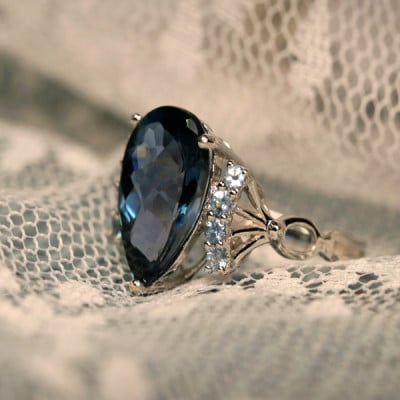TANZANITE GUIDE
(DECEMBER BIRTHSTONE)
What Is Tanzanite?
Tanzanite is a relatively new gemstone on the market, having only been discovered in 1967. However, its interesting origin story and rich blue colour have made it an instant hit with jewellers and buyers alike. It is a semi-precious stone that comes from the zoisite mineral. Its stunning blue comes from a small amount of vanadium present in the mineral.
It is completely unique as it is a pleochroic gem. If you view it from different directions and under different lights, the stone will change colour. It rates at 6.5 on the Mohs hardness scale, making it more delicate than stones like rubies and emeralds.
The 4 Cs of Tanzanite Quality
• Color: The most valuable tanzanites show a vivid blue with violet undertones. Grading systems like GIA's focus on hue, tone, and saturation, with rich, medium-dark blues being the rarest and most priced.
• Clarity: Tanzanite is usually eye-clean, meaning no visible inclusions. However, inclusions like "fingerprint" can affect value.
• Cut: A good cut enhances tanzanite's brilliance and colour. Poor cuts cause "windowing," making the stone look dull by letting light pass through without reflection.
• Carat Weight: Larger stones are rarer and often more valuable, but quality should never be sacrificed for size. The best tanzanites balance both size and vibrant colour.
Where Is Tanzanite From?
The only known site with a deposit of tanzanite is in Northern Tanzania. The mining site is at the base of Mount Kilimanjaro in Arusha. Tiffany & Co took the location of Tanzania as its inspiration for renaming the stone when it hit the jewellery market.
This deposit of the blue zoisite mineral was only found thanks to a lightning strike landing upon it. This discovery has led to one of the most prominent functions of tanzanite. It is thought that the gemstone is able to take negative vibrations and convert them into positive vibrations, much like it took a lightning strike to discover the semi-precious stone. This carries incredible benefits to the wearer on an emotional level. Wearing tanzanite is said to raise your level of consciousness and improve your mental health.
Having only been found in one location, tanzanite is exceptionally rare. It is in fact approximately 1000 times rarer than a diamond.
Is Tanzanite Valuable And A Good Investment?
Its rarity has put tanzanite in demand. While it is generally cheaper than other popular jewellery gemstones, it is the second most popular blue gemstone on the market. Only blue sapphire is more popular with buyers looking for that rich blue hue.
Tanzanite is associated with royalty and it is the birthstone for December. This has added to its value, with December babies everywhere wanting a piece of jewellery with tanzanite at its centre. The most expensive pieces of tanzanite have a strong, vivid hue. The rich blue colour is coveted, as is tanzanite that is blue while also having a violet-purple tone to it.
While tanzanite does not accrue value like a diamond, and will not immediately gain value the day after you buy it, it is a sensible investment for the future. Scientists estimate that, without finding another natural source for the gem, it will be completely mined within the next 20-30 years. This has led to tanzanite being labelled the ‘gemstone of a generation’. Its value is intrinsically linked with its rarity and if it can no longer be mined, there will only be a finite amount of tanzanite to go around.
If you sell to Asian markets, high-quality tanzanite is a good investment. It is popular in Asia, with demand only looking to increase over the next few years.
For a clear, vividly coloured tanzanite stone, you are looking at between £200-400 per carat. The overall price for a piece of tanzanite jewellery will depend on the other stones it is set with, the style of the piece and the type of metal used.
Tips For Buying Tanzanite Jewellery
One of the first things to consider when you are buying tanzanite jewellery is its durability. At 6.5 on the Mohs hardness scale, it is not as strong as other popular gemstones. It is far more likely to scratch than a sapphire or a diamond, so you should bear this in mind before you make your purchase. While this may be fine for earrings and necklaces, it will be harder to keep tanzanite rings free of wear and tear.
The best investment for tanzanite jewellery is a piece with excellent colour clarity and a high-quality cutting grade. As a stone, tanzanite is almost crystal clear. This means you can easily see any imperfections. The higher the clarity, the more expensive the piece.
If you are buying with intent to sell on for profit, think first about who you are selling to. Jewellers generally pay at wholesale prices, so your best options are private collectors and auction houses.
How To Clean A Tanzanite Ring
Much like with your other jewellery, tanzanite is best to clean with warm, soapy water. Use a soft toothbrush or cloth to clean the stone and the underside of the ring. It is best to dry with a soft, lint-free cloth to prevent water marks.
As tanzanite is less durable than other precious stones, storage is of the utmost importance. Make sure it is placed in dedicated storage that will not scratch the stone. It is also wise to take off a tanzanite ring before you do any activities that are likely to scratch it.
Faq
It is easy to spot a fake when it comes to tanzanite. This is due to the fact that it is a pleochroic gem. It shows different colours depending on the angle you view it at. Before you buy, view the piece of jewellery from different directions to see if its colour changes.
You can also spot changes in colour when viewing tanzanite under different types of light. In natural light, you will be able to see that characteristic blue, but under an artificial bulb, you will be able to see the purple with hints of red and pink.
While less strong than other jewels, tanzanite has the perfect symbolism for your engagement. It is associated with good luck, prosperity and new beginnings. It can be used for an engagement ring, but to keep it looking at its best it will require careful care and cleaning.
Tanzanite is cheaper than diamonds. Diamonds still reign supreme where price is concerned. However, it is much rarer than diamonds, meaning it could be a wise investment for the future. Typically tanzanite costs £200-400 per carat whereas diamond can start at £700 per carat.
Tanzanite is predominantly blue. It is a rich, deep blue that leans towards purple. One of the most captivating things about the gemstone is that it actually changes colour. If you change the direction you look at it from, you will see different shades in the stone.
There is no reason you cannot wear tanzanite every day, as long as you are mindful that it is prone to scratching. This is more important in rings or bracelets, where the jewellery will come into contact with other surfaces more frequently.
Want to learn more about birthstone meanings? Check out our birthstone guides by month:
Browse All 12 Birthstone Guides
-

Garnet
January Birthstone -

Amethyst
February Birthstone -

Aquamarine
March Birthstone -

Diamond
April Birthstone -

Emerald
May Birthstone -

Pearl
June Birthstone -

Ruby
July Birthstone -

Peridot
August Birthstone -

Sapphire
September Birthstone -

Opal
October Birthstone -

Topaz
November Birthstone -

Tanzanite
December Birthstone

Article written by Nilesh
 Trustpilot
Trustpilot



